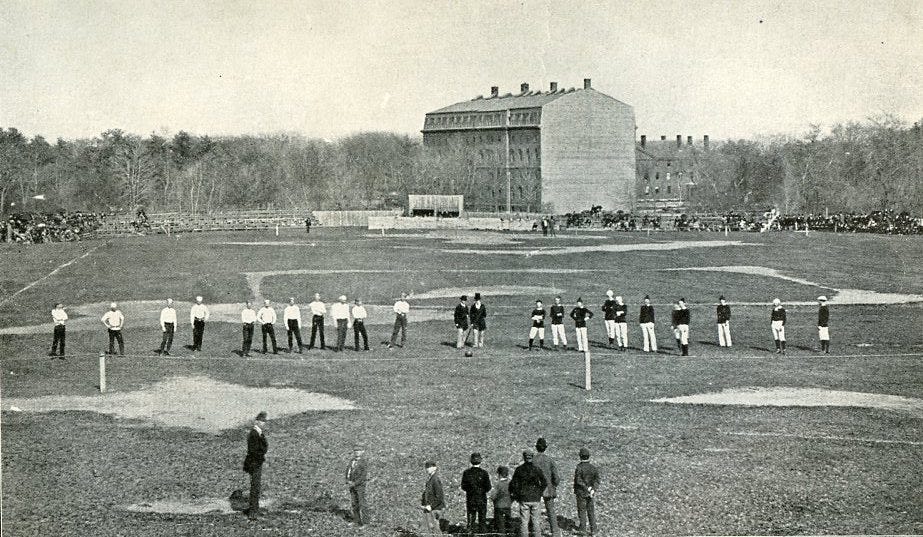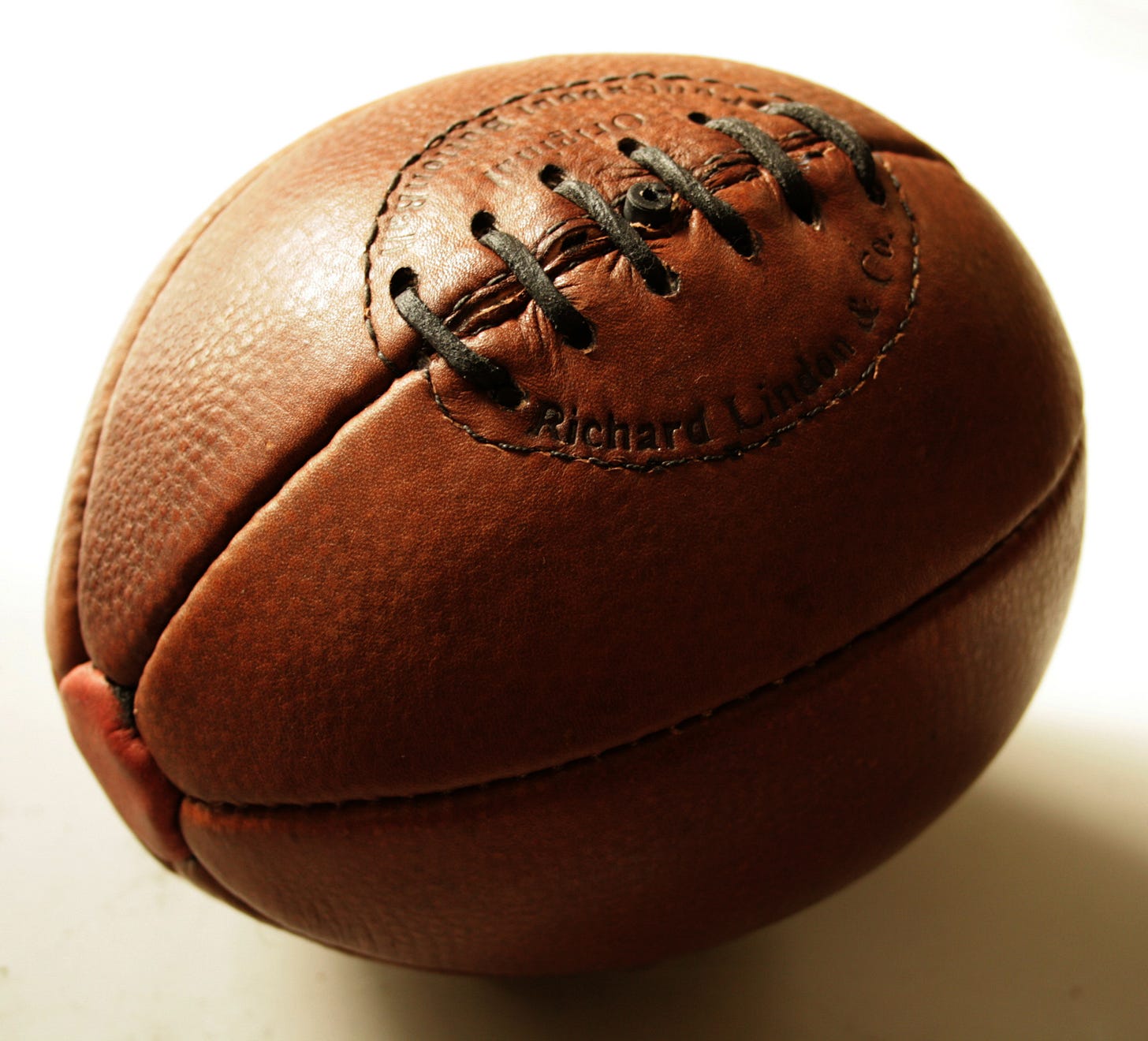The 1874 Harvard-McGill Games and the American Ball
This story is fact-based and ends with speculation. It concerns the games played by students from Harvard and McGill universities 150 years ago yesterday and today that were critical to the development of gridiron football in North America. Had McGill not introduced rugby to Harvard and Harvard not adopted rugby as a result, the gridiron game we know today likely would not have developed. McGill's challenge was an important milestone in football's evolution. Yet, the only thing we know about the ball they used in those games was that it was round.
Background
Students at American universities in the 1860s and 1870s generally played "football" kicking games with rules that varied from campus to campus. They played a similar stew of games in England but began formalizing them in the 1860s into what is now soccer (the Association game) and rugby. The games played in American colleges were soccer-like, but Harvard was an exception. They enjoyed a local Boston game that allowed players to carry the ball.
University students in Canada played rugby, leading the ruffians at McGill in Montreal to challenge Harvard to play two games: one using the Boston rules and the other using the Rugby Football Union rules. They met in May 1874, playing the first game under Boston rules using a round ball, and planned to play rugby the following day using a rugby ball. Rugby balls at the time were plum or melon-shaped with a 30-inch circumference or slightly larger than today's basketball. Unfortunately, the McGill team forgot to bring a rugby ball with them, and they could not find one in Boston, so they used the same ball they had used the previous day. The question is, what type of ball did they use in those games?

Inflated Balls in the 1870s
The various inflated balls used in sports worldwide originated as inflated bladders. A pig or sometimes sheep bladder did the trick and is the likely reason we refer to footballs as pigskins. They tied off the inflated bladder like a balloon, but the bladders’ lack of durability led to encasing them in leather. Pigs and their bladders are not uniform in size and shape, so the footballs made with those bladders were not either. They also were problematic since the pig bladders were inflated by mouth, and those who did the inflating risked acquiring infectious diseases from inhaling air from inside the bladder.
Things began changing when Charles Goodyear developed the vulcanization process and his vulcanized rubber ball in 1855. His ball and those that followed it were round and constructed of rubberized canvas. They became known as the American ball.
Meanwhile, Richard Lindon, a cobbler in Rugby, England, was the first to use vulcanized rubber to produce rubber bladders. His bladders were more robust, eliminated the need for animal bladders, and allowed balls to be manufactured in uniform sizes and shapes. Rubber bladders quickly became the universal innards for leather-covered rugby and soccer balls.

The Harvard-McGill Ball
So, while we know the Harvard-McGill games used a round ball, it remains unclear whether they used a leather-covered soccer ball or a rubberized canvas American ball. For that matter, what round ball did Princeton and Rutgers use back in 1869?

An issue arguing against Harvard and McGill using a soccer ball is that rugby and soccer balls were not widely available in America then, mainly because they were made in England and were luxury goods. The American balls, on the other hand, were made in the good old U.S. of A. and were one-third the price of the imported leather balls.
We know the American ball was available and used by Eastern colleges. One indication is the cover of the 1875 Harvard-Yale game program. They played the match under concessionary rules, combining the rugby and folk games, and the game program cover shows what appears to be a rubberized American ball. (Click the image to see the crosshatching pattern common to the rubberized American ball.)

Walter Camp lent additional credence to the notion that the Harvard-McGill game could have used an American ball. He once recalled that Yale prepared for the 1876 Harvard-Yale game, played under rugby rules, using a round rubber ball. Yale switched to a rugby ball only when they received a shipment of rugby balls a few days before playing Harvard.
So, while we celebrate the 150th anniversary of a critical moment in the game's history, it would be nice to know the style of ball used in those games. Did they use a leather soccer ball or the more widely available American ball, which morphed into a playground ball, so its role in more serious competition has been largely forgotten?
FYI: I'm nearing the release of my next book, The History of the Football, which will be available soon. The book covers the evolution of the gridiron football and the forces that drove its size, shape, construction, inflation, and appearance.
Please comment below if you have information about the ball McGill and Harvard used 150 years ago today.
Football Archaeology is reader-supported. Click here to buy one of my books or otherwise support the site.


Great article. I look forward to your book. Below are a few references to the ball from primary sources:
Dec. 8, 1870, The Indiana Democrat, (PA): "A foot-ball manufacturer, casting about for a light and permanently elastic stuffing for his balls, hit upon sponge cut into small pieces and treated with glycerine. The material proved so decided a success that he patented the idea, sold his patent to be applied in the upholstery purposes for $75,000, and to-day the procurement and preparation of elastic sponge is one of the most flourishing branches of commercial and manufacturing industry."
Dec. 17, 1873, The Titusville Herald (PA) headline "Football at Yale" regarding a game between Yale men and Etonians, quotes the Yale Record: "...The first game was hard fought...After about fifteen minutes play the ball was broken, but Yale having learnt by experience at the Princeton match, had provided extra balls..."
May 11, 1874, The Boston Daily Globe in the "Base ball [sic) Notes" column referring to the "foot-ball" game between Harvard and McGill states: "The ball used by the McGills is simply a bladder covered with leather, and is much harder to kick than the ordinary rubber ball."
Nov. 6, 1875, The Boston Daily Globe in "College Notes" column: "The football eleven are hard at work practicing for the coming match with Yale Concessionary rules have been adopted, so the game will be neither Harvard nor Rugby. A rubber ball will be used."
Source for these excerpts is "The Lost Century of American Football."
Just in case you didn't see this:
Allison Danzig's "Oh, How They Played the Game" (1971) quotes a 1949 interview of 90-year-old Henry Green Duffield, who attended the 1869 game at Princeton as a ten-year-old:
"The ball was not an oval but was supposed to be completely round. It never was, though - it was too hard to blow up right. The game was stopped several times that day while the teams called for a little key from the sidelines. They used it to unlock the small nozzle which was tucked into the ball, and then took turns blowing it up. The last man generally got tired and they put it back in play somewhat lopsided..."